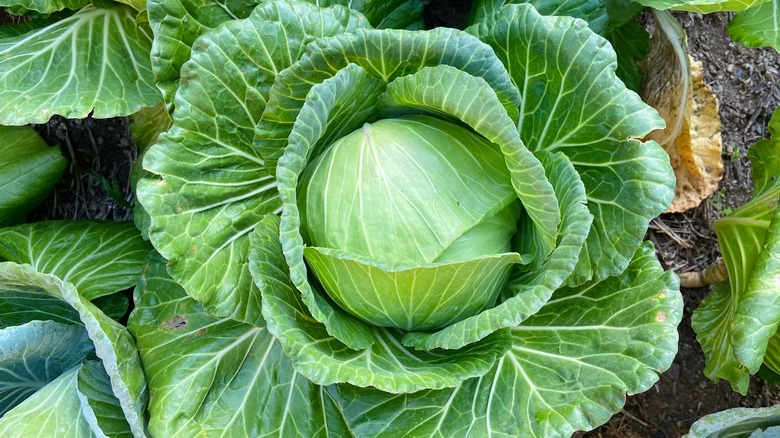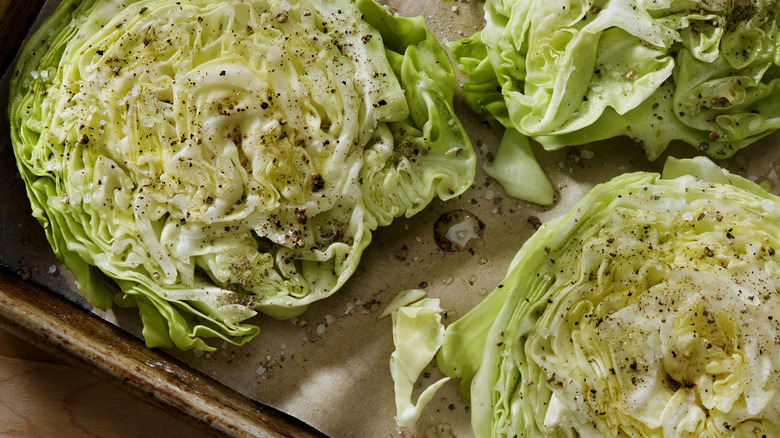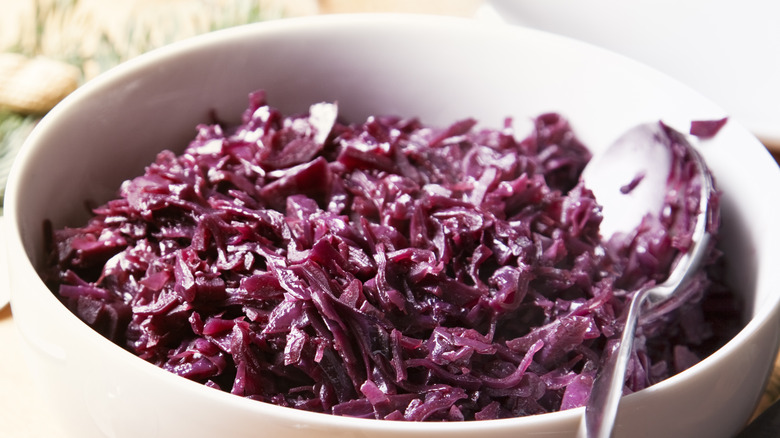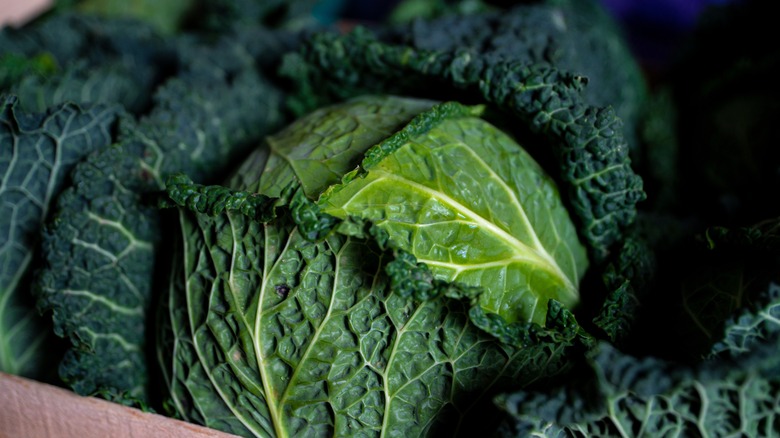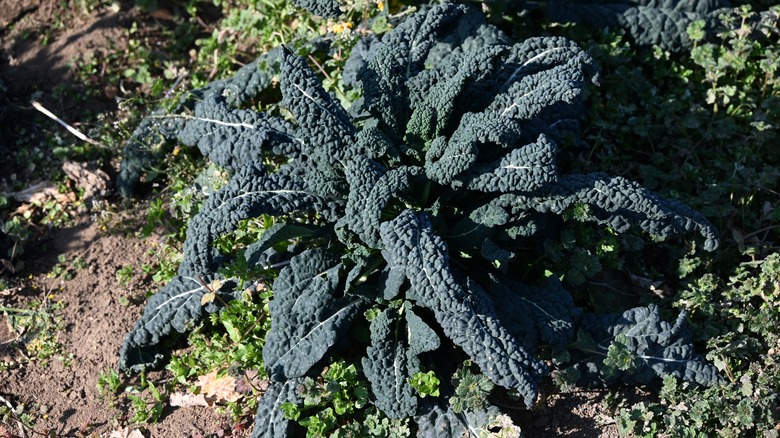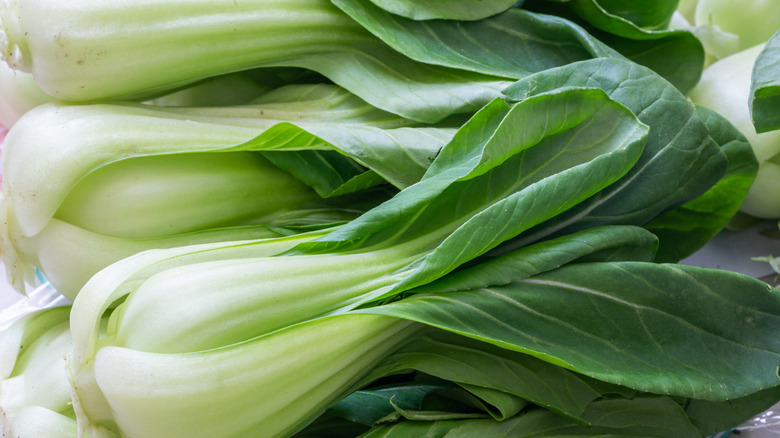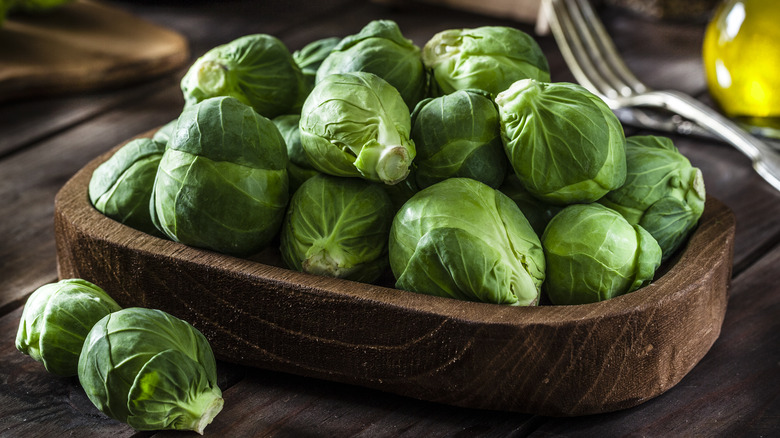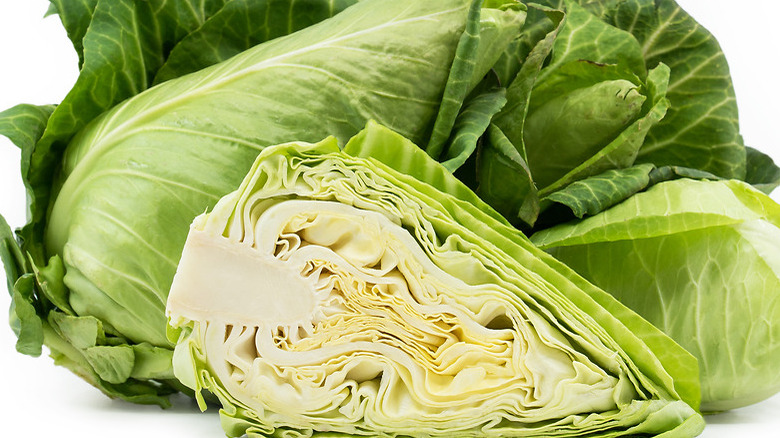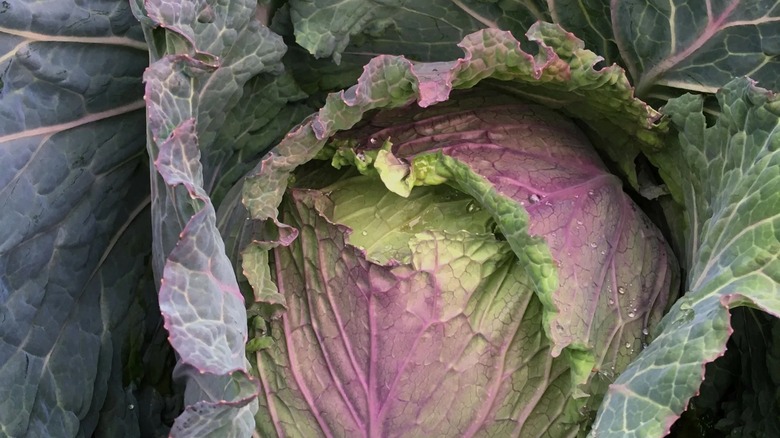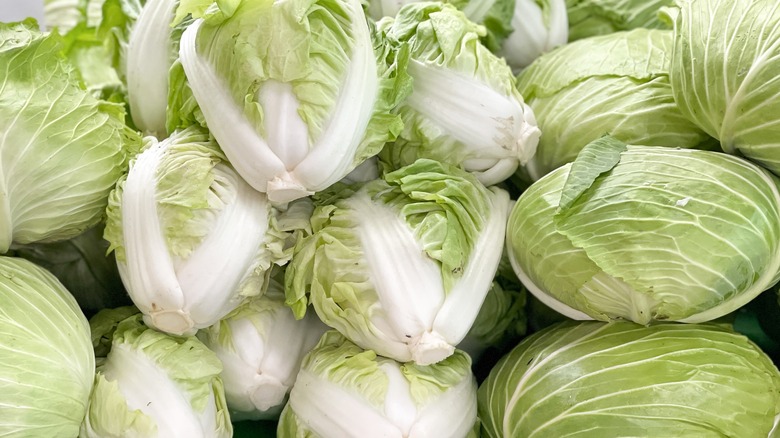9 Types Of Cabbage And How To Cook With Them
Cabbage is a leafy vegetable rich in fiber, vitamins, and minerals with almost no fat. Its earthy-sweet flavor makes it a perfect addition to many dishes. Cabbage comes in many colors and varieties and can be cooked, sliced, chopped, shredded, and served in many different ways. Cabbage can be eaten raw, steamed, stir-fried, roasted, sautéed, or braised to be used in salads, eaten alone, or pickled. One of the most popular uses for cabbage is coleslaw, which is a popular side dish made with finely shredded raw cabbage served with a salad dressing, vinaigrette, or mayonnaise. But kimchi, a longtime Korean staple, has gained popularity over the past decade and can be found in many U.S. households and in this delicious kimchi sundubu jjigae (Korean tofu stew) recipe.
Cabbage comes in three main varieties — green, red, and savory. However, within each of these varieties, you'll find several types. For instance, some popular green cabbage varieties include pointed, domestic, and Danish. Cabbage is closely related to kohlrabi, kale, Brussels sprouts, cauliflower, turnips, and broccoli in the brassica family brassica family — the powerhouses of vegetables. If you're not yet a cabbage fan, we hope to change your mind by introducing you to these types of cabbage and the many delicious recipes that will tickle your taste buds and keep you coming back for more.
Green cabbage
Green cabbage is the most common type of cabbage. It has a round head and densely packed leaves that burst with flavor. Green cabbages typically range from about 1 to 9 pounds or 0.5 to 4 kilograms. Although you may not know it, cabbage is packed with fiber, vitamins, and minerals. Raw green cabbage has only 22 calories and 85% of the recommended daily requirement of vitamin K and 54% of the recommended daily requirement of vitamin C.
Common types of green cabbage include Danish cabbage, domestic cabbage, and pointed cabbage. Although a main ingredient in coleslaw recipes, you can steam, braise, saute, fry, and boil green cabbage to bring out its natural sweet flavor. Think tender corned beef and cabbage. Eaten raw, green cabbage tastes slightly peppery but is much less spicy when cooked. Because it is a hearty vegetable, green cabbage can withstand even the creamiest of dressings and still retain its unique flavor. Fermenting and pickling cabbage add a robust sour flavor to a variety of dishes like sauerkraut and kimchi.
Before cooking, remove any outer leaves that appear brown or wilted and rinse well. Since the center of the cabbage can be tough, cut out the stem and shred or chop it into wedges. Shredded cabbage takes far less cooking time, about five minutes. When cooked, the cabbage will be fork-tender. If your family finds the odor of cabbage cooking objectionable, add a small amount of vinegar — a little less than a tablespoon — to the water.
Red cabbage
Red cabbage's purple-magenta hue is unmistakable. To showcase its natural flavor, you can sauté it, use it raw, grill it, braise it, slow simmer it, use it in an old-fashioned cabbage soup recipe, and much more. Red cabbage is high in potassium, vitamin C, vitamin A, minerals, and antioxidants and tastes very similar to green cabbage, no matter how you cook it. Most people use it in coleslaw or other cold dishes, but red cabbage is also yummy when added to your best sauerkraut recipes or sauteed to bring out its natural sweetness. Pickled red cabbage is a great counterpart for cold meats, cheese, and smoked fish. Plus, it can provide a healthy boost to your diet when juiced. Some popular varieties of red cabbage include red express, ruby ball, and red drumhead cabbage.
Before cooking, rinse the head of cabbage in cold water and pat dry. Remove any wilted or brown leaves. Slice the head into wedges or shred it. If sautéing, cut the cabbage into thin slices, about one inch thick. When slow-simmering red cabbage, cut the cabbage into small wedges and add it to the pan. Steamed cabbage can be bland, but roasting it makes the flavor pop and adds texture. There are so many cabbage recipes you are sure to love.
Savory cabbage
Savory cabbage, sometimes called curly cabbage, is similar to green cabbage but milder in flavor. It has wrinkled, rich, dark-green leaves with a characteristic curl at the ends. Savory cabbage has almost twice as much protein and fiber as other varieties and is high in vitamins A, K, C, and B6, , making it a superfood and a much-loved companion to any meal.
Savory cabbage comes in many varieties, including Savory Ace, Savoy King, Savory Queen, and Quintal D'alsace. Savory cabbage can be combined in many recipes and pairs well with various spices, chestnuts, apples, onions, dill fennel, and horseradish. Savory cabbage is used in casseroles, sauteed, or roasted to extract the most flavor. It is best when cooked slowly to maintain its delicate texture. Because the outer leaves are dark green and the inner leaves are yellow, you can use them in different ways. Wrap the outer leaves around your favorite meats and simmer them slowly when making homemade pasta sauce. Savoy cabbage is also delicious when served raw in salads or as a topper for burgers.
To prepare savoy cabbage, remove the leaves and rinse them separately. Discard any brown or damaged leaves. You can cook savory cabbage just like other varieties of cabbage, but it is less suitable for sauerkraut. That's because savory cabbage tends to ferment more quickly than other cabbages, and you may end up with softer sauerkraut.
Black cabbage
Black cabbage, sometimes called Tuscan cabbage or Lacinato kale, is native to Tuscany, Italy. It is rich in vitamins C, A, and K, iron, calcium, and potassium. In fact, it contains more iron than beef, more calcium than milk, and more vitamin C than one orange, which makes it a super inexpensive way to add nutrition to your diet. Black cabbage has long, dark green (almost black) leaves that are wrinkled, narrow, and bumpy. Unlike curly kale, black cabbage leaves are not as tightly curled. The flavor is typically robust with a tangy bite and sweet aftertaste, making it more palatable for some people than many other types of cabbage.
Black cabbage is a culinary superstar, lending its unique flavor and texture to various dishes. It shines in this easy Ribollita soup recipe, is a common ingredient in pasta recipes, and is a delightful side dish when sauteed or stir-fried. But its' versatility truly comes to life when eaten raw. It can be chopped and added to coleslaws and salads for a fresh crunch or used as a flavorful element in a sandwich.
When choosing black cabbage, look for crisp leaves with no browning or yellowing. It stores well in the refrigerator for up to a few months when wrapped in a damp paper towel and placed in a plastic bag or airtight container. Before cooking, rinse thoroughly and remove any tough stems.
Bok choy
Bok choy, also known as Chinese cabbage or pak choi, has a mild yet somewhat sweet flavor that is often compared to Swiss chard or spinach. Bok choy stems are crisp and crunchy, while the leaves are tender. Like other types of cabbage, bok choy is versatile and can be used in soups, stews, stir-fry, and used raw in salads. It can be boiled, sautéed, steamed, or even grilled to bring out its natural flavor. You can cook the stems and leaves together or separately, depending on the desired texture.
Bok choy is also rich in vitamins and minerals. In fact, a single serving of bok choy can contain calcium, iron, magnesium, potassium, zinc, vitamin C, vitamins A and K, with zero fat and only one gram of sugar. And, it's never been easier to enjoy the earthy flavor and reap its nutritional benefits than in this grilled bok choy recipe.
Before using, rinse with cool water to remove excess dirt and pat dry. If you plan to saute or stir-fry bok choy, check to be sure the inside is also dry, or you may have wilted and spongy leaves.
Brussels sprouts
Brussels sprouts are thought to have originated in ancient Rome but later grown in the Brussels region of Belgium — thus their name. With a distinct flavor that can be described as slightly nutty, Brussels sprouts become much sweeter when cooked. According to Very Well, they are nutrient-dense and deliver over 100% of the recommended daily value of vitamins C and K, fiber, protein, and folate in a nearly fat-free package. Frozen Brussels sprouts are similarly nutritious. Brussels sprouts can be found year-round, but their peak season is from early autumn through winter. When ripe, they should be hard, green, and compact, usually measuring about 1 to 1½ inches in diameter.
Brussels sprouts are generally roasted to bring out their natural sugars. They can also be sauteed or steamed. You can enjoy them in a stir-fry, as a side dish, in soups and stews, or served raw in a salad. They can also be canned or pickled and are sometimes added to recipes in the place of olives. Brussels sprouts can stay fresh longer if stored properly and are best kept in a dry, cool environment. You'll know when they start to go bad as they will start showing signs of yellowing throughout. Before cooking, wash them well and remove any brown or wilted leaves.
Conehead cabbage
Conehead cabbage is a staple in East Asian cuisines but is becoming more common in other cuisines worldwide. It has an oblong-shaped head with tightly packed green to pale green leaves and a mild flavor that is both sweet and slightly peppery. The leaves are crisp and tender, suitable for cooked and raw preparations.
Conehead cabbage is incredibly versatile. It can be chopped and served in salads and coleslaws or as a crunchy element in a sandwich or burger. It is also often a key ingredient in kimchi but can be used in soups and stir-fry. Conehead cabbage can be steamed, sauteed, or braised as it retains both its shape and flavor well. The leaves can also be used as wrappers for dumplings and spring rolls, like in this light and fresh spring rolls recipe. Besides a delicate flavor, the Gardening Magazine points out that conehead cabbage is low in calories and packed with essential vitamins and minerals, including vitamins K and C, folate, and potassium. Like other cabbages, rinse well and pat both the outer and inner leaves dry before cooking or eating raw.
January King cabbage
January King cabbage is a winter cabbage variety known for its hardiness and ability to withstand colder temperatures. The outer leaves have a pink and purple hue, while the inner leaves are pale green to almost yellow. Raw or cooked, the flavor is robust with a slight peppery kick. Because of its compact and sturdy texture, January King cabbage is well-suited for roasting and braising. It can be used in stews and soups, eaten raw in salads and coleslaws, or fermented.
The outer leaves of the January King can be used for wrapping or stuffing with other ingredients, like when making any number of cabbage rolls. Overall, the taste of a January King cabbage is well balanced, and stands up to a variety of spices, from cumin and cinnamon to allspice and garlic, making it a popular choice among cabbage lovers.
January King cabbage also provides as much protein and fiber as other varieties of cabbage and is high in vitamins C and K, making it a nutritious companion to any meal. Before using, trim off all wilted or brown leaves, rinse well and pat dry, then chop into whatever size and shape you like.
Napa cabbage
Napa cabbage, also known as Chinese cabbage, is a variety of cabbage that is readily available in most major grocery stores. It has a tender texture and is slightly sweeter than green or red cabbages. Napa cabbage is often used in stews and soups or as a tasty stuffing for dumplings. Try Napa cabbage tossed with noodles, shredded in a coleslaw or roasted to bring out its natural sweetness. Equally important are the nutritional benefits of Napa cabbage, including a generous amount of vitamins B, K, and C, folate, calcium, potassium, phosphorus, manganese, iron, and magnesium, but with just 16 calories per 100 grams of fresh leaves.
The Napa cabbage has a mellow taste and a crisp texture. It has thick white ribs and elongated, light green leaves and is often a main ingredient in kimchi. On a cold and rainy night, try this vegetable wonton soup recipe. Or if you prefer a fresh taste, finely chop the Napa cabbage leaves and combine them into this cabbage salad. But first, trim any brown or shriveled leaves and rinse thoroughly.
